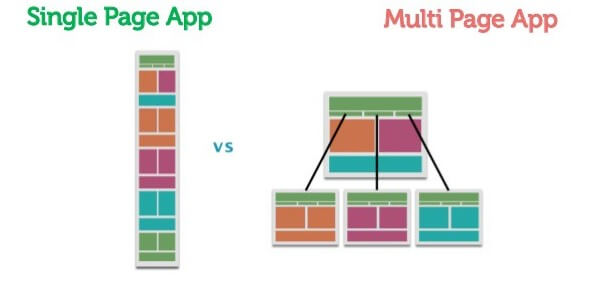MPA vs SPA: How to Choose Between Traditional Web Apps and Single Page Applications

Web applications are swiftly replacing old desktop apps. They are more convenient to use. They are not bound to one device. They are easy to update.
However, the demand for complex and refined applications is still growing. If you are thinking about building your own application, you’ve probably heard about two core design patterns for web apps – SPA and MPA. Single-page applications are becoming more and more popular. No need to discover continents, just recall YouTube, Facebook, GitHub, Google Maps, or Hygger. Multi-page applications make up the majority of websites on the Internet.
In this article, we are trying to evaluate both solutions objectively, defining their key characteristics, as well as their pros and cons.

Before you start turning your idea about the best app into real life, you need to answer a set of essential questions. In order to define what app model is better for your needs, you should follow the content-first approach, that is focused on the importance of putting your app content before everything else. So, initially try to determine what content you want to present and what content your users will care about the most.
What is a Single-Page Application?
A single-page application is a solution that performs inside a browser and does not require page reloading during its use. Unsurprisingly, you are using this type of apps daily.
Single-page applications try to imitate a natural environment in the browser. They do not require page reloads and extra wait time. A SPA is just one web page that loads all other content using JavaScript. SPA requests data independently and renders pages straight in the browser. Single-page sites assist to keep users in one comfortable webspace.
What is a Multi-Page Application?
A multiple-page app works in a traditional way where every change displays the data or submits data back to server requests rendering a new page from the server in the browser.
Such solutions are bigger than single-page applications. These apps have many levels of UI because of the amount of content. Amazon or eBay are great examples, as well as other complex sites with multiple pages.

SPA vs MPA: Defining Pros and Cons
What are the advantages of single-page applications?
- Ability to reuse code.
- The process of development is simple and friendly: no need to write code to render pages on the server.
- SPAs work fast, as most resources are only loaded once throughout the lifespan of the app.
- SPAs are easy to debug with Chrome.
- They can effectively cache local storage.
- Ability to work offline.
What are the benefits of multi-page applications?
- Multi-page apps may include as much product info as required, with no page restrictions.
- Faster initial page load.
- MPAs are easy and good for SEO management.
- They provide a visual map of where to go with clear menu navigation.
- MPAs provide lots of analytics and data about how a website works.
- MPA development is a cost-effective approach.
SPA cons
- The high risk to damage SERP ranking. One page SPAs’ ranking is affected.
- Not friendly navigation.
- Disabled JS can hinder the proper functioning of the application.
- Security threat during SPAs development because of the cross-site scripting.
- Space constraints.
MPA cons
- Tedious development process because of tight coupling between the front end and the back end parts.
- Performance speed decreases.
- Loading time increases.
- Mobile development is not easy because you cannot use the same back end code.
- Maintaining security may become a challenge, as developers have to secure each separate page.
Now let’s dive into details.

SPA vs MPA: What to Choose?
Let’s briefly explore the key characteristics of the SPA and MPA approaches.
 Speed
Speed
Speed is an essential factor in this context. People get more and more impatient and their attention spans are getting shorter.
- Single-page applications load faster because the majority of app resources are loaded just once. When a new piece of data is requested by the user, the page doesn’t reload entirely.
- A multiple-page app is slower as the browser must reload the entire page from scratch every time the user wants to access new data or moves to a different website’s part.
If the app or website is image-heavy then choosing a SPA is a safer option.
 User experience
User experience
Any SPA looks more mobile-friendly. You should care about this fact, as a lot of traffic comes from mobile devices. Frameworks applied in single-page app development enable you to develop mobile apps.
On another hand, an MPA enables better information architecture. You can create as many pages as required, including as much information on a page as you need with no limits. Users can easily find their way around the website thanks to the clear navigation. It positively impacts their experience.
 Development process
Development process
The reusable backend code is one of the greatest benefits of single-page applications. And definitely, reusable code requires less work. It is possible to apply the same code you used in your web app to your native mobile application.
Additionally, thanks to the clear division between front-end and back-end, both parts can be developed simultaneously. It accelerates the entire development process. MPA’s require more time because in most cases, the server-side has to be coded from the beginning.
 SEO issues
SEO issues
Search engine optimization is one of the weaknesses of single-page applications. SPAs are not as SEO friendly as MPA’s. The majority of SPA solutions are run on JavaScript, which most search engines do not support.
Multiple-page applications allow better website positioning as each page can be optimized for a different keyword. Additionally, you can include meta tags on every page. It will positively impact Google rankings.
 Coupling
Coupling
In SPAs, front-end and back-end are separate. Such applications use APIs developed by server-side developers for reading and displaying data.
Front-end and back-end in MPAs are more interdependent meaning that all coding is usually housed under one project.

 JavaScript dependency
JavaScript dependency
SPA lives in accordance with JavaScript. It can be problematic. More search engines started to support JS but with varying results. This support strongly depends on the JS framework used.
JS reliance also contributes to its problems with SEO and security issues. Multiple-page applications can be created without any JavaScript dependency.
 Security
Security
The larger the website the more effort it takes to secure it. Choosing
MPAs, you will have to secure every webpage. In SPA, all you need to keep your page safe is secure data endpoints that look much faster but not necessarily safer. Besides, SPAs are more prone to hacker attacks.
Conclusion
Both SPA and MPA are not flawless as they obviously have their pros and cons. SPA is the best choice if you care about speed and code reusability that can be applied to develop a mobile app. However, it has deficiencies in SEO optimization. MPAs win in case you strive to be ranked higher in Google, and it is more scalable but much slower than single-page applications.
Choosing the best option, you should always have your business goals and requirements in mind.



